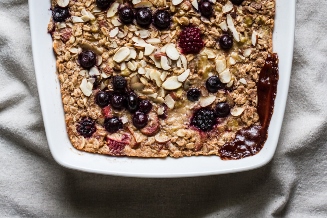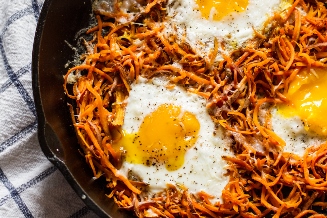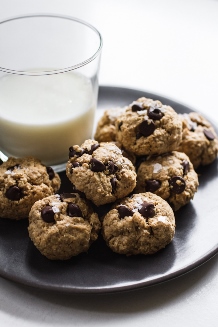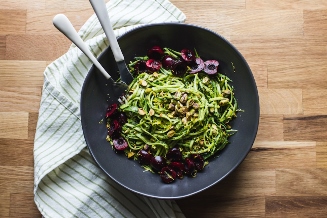(Very Green) Vegan Pesto Pizza
/Friday = pizza night
Am I right?
And this Friday we’re having this vegan pesto pizza. It’s the bees knees, yo. Actually, we ate this on Tuesday. And Wednesday. But you can eat it today!
Chris could straight up live off pizza. He will eat pizza for any meal, any day of the week, multiple days in a row. He eats a million other things besides pizza but would most likely prefer pizza all-of-the-time.
Typically I’ll make tortilla pizzas that I crisp to a browned perfection under the broiler on both sides before adding any toppings. He loves them and it keeps me from hassling with making dough. Tortilla pizzas are a quick weeknight meal on heavy rotation around here.
But on this pizza night, I busted out the real thing.
I wanted to try my hand at an all-vegan pizza filled with veggies. But veg-heavy pizzas can sometimes be soggy or too heavy and when using red sauce I always seem to feel like it needs cheese.
Enter vegan pesto! Vegan pesto without nutritional yeast that tastes completely amazing, if I do say so myself.
It’s adapted from a pesto recipe I made in the summer that swirled between a bowl of zucchini noodles and cherries. I’m not sure if I’ve ever actually made pesto with pine nuts. Anyone else? Both the summer pesto and this pesto are made with pistachios. I might deem pistachios the best pesto nuts ever.
Now for the roasted veggies.
I very rarely buy broccolini because of it’s high price tag for what you get (typically a small bunch). I got to thinking that it would probably be a better fit on pizza in comparison to regular broccoli because of it’s long and slender stems and less tightly packed florets. Definitely the right decision and it was on sale. Win!
I roasted thinly sliced brussels sprouts and onion alongside the broccolini.
I don’t know much about bread baking and yeast but I have figured a few things out. In this pizza dough recipe you’ll want to proof the yeast before mixing it in with the other dough ingredients.
The process of proofing yeast is really just to make sure your yeast is still alive.
You want your yeast mixture to puff up just like you see below. If it doesn’t, here are a few reasons you may be having trouble.
- Your mixing liquid is too hot or cold. The milk (or more commonly, water) should feel warm, not hot to the touch. To control this I heat the milk on the stovetop until just warm. I’ve people specify a range of temperatures between 75° – 105° but have never actually used a thermometer to test my temp.
- Make sure the bowl you’re adding the yeast to is not cold. Rinse the bowl with hot water to take the chill off. (Our cupboards are cold because they’re on the exterior wall of our house. #oldhouseproblems)
- If it doesn’t puff up, make it again with a fresh packet of yeast.
I could have screamed after taking these photos. I forgot the kalamata olives, which are basically my new favorite topping on ev-er-y-thing.
They’re the perfect salty, juicy bite. And I forgot them.
Just picture the pizza below dotted with sliced kalamata olives. Yep, great job.
And if you really want some cheezy flavor but still want to keep things vegan, sprinkle on some of my very favorite vegan parmesan cheeze. I keep this stocked in the fridge at all times.
Very Green Vegan Pesto Pizza
gluten-free, vegan // yields 2-3 servings for 1, ~18x9-inch pizza
- 2 medium cloves garlic, peeled
- 1/2 cup roasted, salted pistachios
- 4 loosely packed cups zesty baby greens (baby arugula + kale work great)
- 2-4 tablespoons lemon juice
- 1/4 – 1/2 teaspoon salt and pepper
- 1/3 – 1/2 cup extra virgin olive oil
- 1 bunch broccolini, ends trimmed + stalks sliced in half
- 6-8 brussels sprouts, stems removed +thinly sliced
- thinly sliced yellow onion
- 2 teaspoons extra virgin olive oil
- sliced kalamata olives
- gluten-free pizza crust (yields 3 crusts)
While your pizza dough is rising preheat your oven to 375° F.
Place garlic in a food processor and turn on until minced. Add the pistachios and turn on until well chopped. Add in the baby greens, 2 teaspoons lemon juice, and 1/4 teaspoon salt and pepper. Pulse to combine until greens are incorporated. Scrape the sides of the bowl as needed. Turn the processor on (or pulse) while slowly streaming 1/3 cup olive oil into the top of your processor. I like mine left with a bit of texture but process to your desired consistency.
Taste and adjust flavors if necessary. If your pistachios weren’t heavily salted you will probably need to add more. I like to add more lemon juice and a bit more olive oil for easier spreading on the pizza.
Place veggies on a baking sheet and toss with the 2 teaspoons of oil. Sprinkle with salt + pepper. Roast until lightly golden brown and tender, about 18 – 24 minutes. Toss 1-2 times while they roast. Set aside.
Roll out pizza dough and bake per these instructions (or use any other thin-crust pizza dough recipe).
Spread a thick coat of pesto on your pizza and top with roasted veggies (you'll probably only use 1/2 of the broccolini for one pizza) and the olives. Bake at 425° F (oven should already be hot from baking the crust, preheat if not) for 2-3 minutes until the veggies and pesto are hot. Do not over-bake or pesto will dry out.
Top with a drizzle of olive oil and sprinkle of salt and pepper if desired.
Notes:
- Pesto should cover about 1 large pizza. You want a thick coat of the pesto if you’re not also topping with cheese. If using cheese (I recommend goat or parmesan) you can go a little lighter on the pesto.
- If your pesto was previously refrigerated, bring it to room temperature for easier spreading and add a bit more olive oil and lemon if needed.
- The pesto will taste very garlicky on its own but works well on top of this crust and with veggie toppings.
Pizza Dough Tips:
- Step by step instructions can be found here.
- Roll the dough very thin for best results with this combination, 1/8-inch is ideal.
- This dough does not store well in the fridge after rising. It dries out. It’s best rolled and baked after rising. If you do want to make ahead, I had success rolling mine out and baking then letting them cool on the counter. I heated them at 425° for a few minutes longer then topped and baked to heat the toppings. I haven’t tried refrigerating the baked crust to be used the next day, but it might be another option.
- Make sure your flours are very finely ground.
- Make sure your dough rises. If not, it will be very dense and not nearly as tasty.
Yeah. I think I could handle this every night of the week.
Weeeek-end!!
Ashley






















